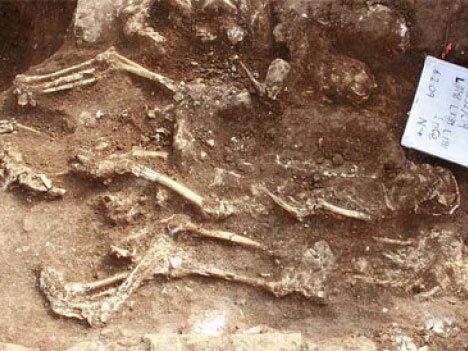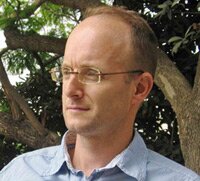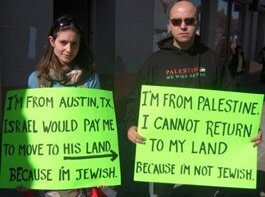Haaretz: Skeletons, High Court rulings, bigwigs embroiled in other scandals, a world-famous architect and some Hollywood panache − all are part of the story of the Museum of Tolerance, slated for one of the most sensitive parts of Jerusalem: on top of a Muslim cemetery. For the first time, Haaretz reveals evidence of a highly dubious, five-month rescue excavation that took place secretly on the site, plus other previously unknown details. A three-part saga.
IOA Editor: This important Haaretz investigative report consists of six articles covering different aspects of the development of the Jewish “Museum of Tolerance” to be constructed atop the historic Muslim Mamilla Cemetery. The Haaretz Hebrew website series is entitled (as of 18 May 2010) “Museum of Intolerance” and the English website series is entitled “Museum of Tolerance Special Report.” The latter version is included on the pages of the IOA.
Why is this report important? The Mamilla Cemetery is a Muslim cemetery with thousands of grave sites that go back some 1200 years. Grave sites are sacred to both Islam and Judaism. This case demonstrates vividly how important it is for Israel to eradicate every possible trace of Palestinian life from the history of Palestine – chapters of history that document non-Jewish life – and doing so even at the risk of embarrassment and international criticism. And while the erasure of the history of the Palestinian dead is important, it actually compliments a far greater injustice: the razing of some 500 Palestinian villages by Israel during the 1948 Nakba and the Occupation.
As is often the case, Haaretz’ two language versions need not be the same and, as indicated by the different series headers, the English version may be toned-down or lack important details, sometimes those that are more critical of Israel than the Haaretz editors wish to publish outside of Israel.
By Nir Hasson, Haaretz – 18 May 2010
www.haaretz.com/magazine/museum-of-tolerance-special-report/museum-of-tolerance-special-report-part-i-holes-holiness-and-hollywood-1.290924
On the connection between the esteemed California-based Simon Wiesenthal Center, run by one of America’s most famous rabbis, an enterprising Jerusalem contractor and the feverish excavation at what was then probably Israel’s most secret civilian building site
‘Removal of nuisances’
Sometimes a lack of sensitivity or even an innocent mistake exposes a major truth. On the Web site of Moriah, a public company for infrastructure work that belongs to the Jerusalem municipality, one can find descriptions of various projects in which the company is involved. Among them is the Museum of Tolerance: “The Simon Wiesenthal Center, the entrepreneur for the construction of the Museum of Tolerance in central Jerusalem, asked Moriah to carry out preparatory and infrastructure work for the project,” says the site. Immediately afterward, under the heading “Objective,” it says: “Carrying out infrastructure work, removal of nuisances in the area of the project …” What the site calls “nuisances” are in fact skeletons, bones and skulls. Hundreds of skeletons that were buried in Jerusalem’s central Muslim cemetery over a period of some 1,000 years.
A Haaretz investigation indicates that the “nuisances” were cleared away from the site swiftly and clandestinely during five grueling months of nonstop work. Testimonies of participants who worked at the site, which were recently obtained by Haaretz, indicate that the skeletons were removed as quickly as possible to enable the start of construction on the museum. “That wasn’t archaeology, it was contract work,” claimed one of the workers.
The story of the Museum of Tolerance is one of a clash between worlds, between the concealed subterranean world of dead bodies − members of the Muslim community who were buried in the soil of Jerusalem − and an American Jewish institution in Los Angeles with Hollywood-style panache. The institution is headed by Marvin Hier, an American Jew who has an open door to U.S. presidents, and the man who brought California Governor Arnold Schwarzenegger to Israel for the museum’s groundbreaking ceremony in 2004.
The High Court of Justice was also involved in the story, with several petitions placed on its desk in an effort to prevent the realization of the ambitious and controversial project. The permission finally granted by the High Court to go forward was based on a controversial opinion submitted to it by the Antiquities Authority, and on the fact that the project was supposed to be designed by preeminent architect Frank Gehry, who has since withdrawn from the assignment. Also involved in the affair are two prominent former members of the Jerusalem municipality, who are currently suspected of criminal offenses in other real estate projects: former prime minister Ehud Olmert, who was mayor of Jerusalem, and former municipal engineer Uri Sheetrit.
Also involved in the story are Tel Aviv University and an archaeologist who works for the university, Alon Shavit. Shavit is a key figure in this story, who has held many jobs related to moving the graves located beneath the land on which the museum is slated to be built. Among other things, he was the expert responsible for the removal work and the contractor in charge of carrying it out, and the company he established paid the excavators’ salaries.
There are also arguments among archaeologists regarding the method used to carry out the excavations, which were done under a heavy cloak of secrecy over five months of round-the-clock work. Now all that is left in the long and complex unfolding of events is a large lot with a huge open pit, in the heart of the city of Jerusalem.
To this day, for most Jerusalemites, the Museum of Tolerance is the six-meter-high metal fence that surrounds a construction site that has been off-limits for the past six years. Unlike most other building sites − here it is difficult, if not impossible, to find a slit through which to peek inside. Along the top of the fence are security cameras and spotlights; parts of it are edged with barbed wire. During the months of excavation the site was probably the most secret civilian construction site in Israel. Today it is quite deserted, after the project encountered financial difficulties and architect Frank Gehry withdrew.
At the moment the future of the museum is unclear. Journalists and public figures are now invited to visit the site, but in fact nothing remains to be seen, other than a large pit. But if we could go back to the period from about November 2008 to April 2009, we would see a place bustling with hundreds of workers employed in the excavations in three shifts around the clock.
The five months of excavation are documented in a series of exclusive pictures that are published here for the first time. In one picture a worn cardboard box takes up most of the photograph. Someone drew a schematic bone on the box as in a child’s drawing and wrote “scattered items,” and afterward erased the words. Other words are also erased. The number 4316L marks the “locus” − a sequential serial number in archaeological jargon. The box is far too small to contain the bones that stick out from both sides; the cover doesn’t close and is torn. At least one bone looks as though it broke in the course of the work, according to the archaeologists, since the fracture line looks fresh and light in color.
Another photograph depicts an ancient skull that was apparently exposed to the light hundreds of years after its owner was buried in the Jerusalem soil. In the area of the crown one can see new fractures, perhaps from an imprecise blow from a hoe. Above it there is still a large rock, and to its right a cardboard box. In the top half of the picture one can sees it is broad daylight and young Israelis, the excavators, are engaged in their work. Anyone who so wishes can perhaps find in the hollow eyes of the skull a look of amazement at what it is seeing.
In the past two weeks, in the open parts of the site that still constitute a cemetery, workers have suddenly begun to show up among the graves: As with a huge puzzle, the workers are reassembling the tombstones and more or less restoring the graves. The workers are emissaries, not of the government, but of the northern branch of Israel’s Islamic Movement.
Mohammed’s companions
The Ma’am Allah cemetery (the name would eventually be distorted to “Mamilla” and expanded in meaning to describe the entire area) originated in medieval Jerusalem, at the start of the last millennium. Burial at the site continued until the early 20th century. Muslim tradition has it that Prophet Mohammed’s companions were also buried here. Another tradition mentions the burial of 70,000 of Saladin’s soldiers in the same place. At its peak the cemetery covered an area of about 200 dunams (some 50 acres), so that in effect today large parts of downtown Jerusalem are built over graves.
According to estimates, the cemetery included most of Independence Park, the Experimental School, Agron Street, Beit Agron, Kikar Hahatulot (Cats’ Square) and other areas. The change in the situation of the cemetery began with the process by which Jerusalem expanded outside the walls of the Old City, in the mid-19th century: By then it was no longer in a distant, peripheral area, but rather was in the heart of a growing, modern city. That was also the start of tensions between respect for the dead and tradition on the one hand, and the value of the land, which was worth its weight in gold, on the other. Like many other Muslim cemeteries in Israel, this one was also neglected for many decades, and today is overgrown with weeds and full of broken tombstones.
In the past two weeks, in the open parts of the site that still constitute a cemetery, workers have suddenly begun to show up among the graves : As with a huge puzzle, the workers are reassembling the tombstones and more or less restoring the graves. The workers are emissaries not of the government but of the Northern Branch of Israel’s Islamic Movement.
It is hard to think of anything further from the old and crumbling cemetery than the life of Rabbi Marvin Hier, the founder and director of the Simon Wiesenthal Center in Los Angeles, and one of the most important and influential rabbis in the United States. A series of pictures of Hier afford us a small glimpse into his world; among the pictures he is seen in the company of two presidents, George W. Bush and Bill Clinton; one pope, John Paul II; and a large number of actors: Arnold Schwarzenegger, Will Smith, Whoopi Goldberg, Ben Kingsley and others. Hier received permission from the late legendary Nazi hunter, Simon Wiesenthal, to name the institution after him.
The first Museum of Tolerance that was built by Hier, and opened in 1993 in Los Angeles, became amazingly successful, with a quarter of a million visitors a year who come to view the exhibits and to participate in the interactive displays in which the museum specializes. One of Hier’s great achievements was the passage of a law in the state that requires students and members of the security forces in California to visit his museum.
That same year, toward the end of Teddy Kollek’s final term as mayor of Jerusalem, the idea of building a Jerusalem branch of the Museum of Tolerance − a “Center for Human Dignity-Museum of Tolerance Jerusalem,” by its full name − was considered. It was a concept that was promoted enthusiastically during the tenure of Kollek’s successor, Ehud Olmert. “A glorious project that in addition to its cultural and educational objective will also constitute a work of art in itself and a site that will attract tourists to Jerusalem and contribute to the tourism industry in Israel as well … “ − thus the museum is described in the Wiesenthal Center’s reply, submitted to the High Court, to the Islamic Movement’s petition for a ban on work at the site.
The initiators of the project say it was Kollek who first suggested creating a Museum of Tolerance in his city, after a visit to the original institution in Los Angeles. Kollek’s associate Ruth Cheshin, president of the Jerusalem Foundation, which the late mayor founded, remembers things differently: “He was in favor of a museum of tolerance, but didn’t like the idea proposed by the Wiesenthal Center. He said that this was not Los Angeles, and a museum for tolerance should grow out of the place rather than being ‘imported.’”
Kollek’s successor, Olmert, was also opposed to the idea at first. Also among the opponents were Yad Vashem in Jerusalem and the Beth Hatefutsoth Diaspora museum in Tel Aviv, which feared the competition.
“Building the museum is unnecessary. It is totally unacceptable and irregular for the government to put land at the disposal of foreign citizens who do not represent any group among the Jewish people,” said the spokeswoman of Yad Vashem at the time, Iris Rosenberg.
As a result of the pressure, the initiators of the museum promised not to deal with the Holocaust, and Yad Vashem removed its opposition, as did Olmert, who subsequently became an enthusiastic supporter of the museum.
The paths of the Wiesenthal Center and Ehud Olmert also cross in the indictment now being deliberated on in the Jerusalem District Court in the so-called “Rishontours” case. According to the charges, at the end of April 2003, Olmert traveled to Paris and New York, with his expenses being covered by three organizations. One of them was the Wiesenthal Center, which paid $5,765 for the trip. Hier’s son Abe is one of the witnesses for the prosecution. Two Olmert associates − his attorney Eli Zohar, and his spokesman from years in the Jerusalem Municipality, Haggai Elias, were also employed by the project entrepreneurs.
The museum’s site, at the corner of Independence Park in downtown Jerusalem, was chosen after a number of other locations were rejected − among them plots near the museums on Givat Ram, the old nature museum in the German Colony and even property in East Jerusalem. The site chosen was familiar to everyone as a parking lot, which had been serving those who visit the city center since the 1960s. Apparently nobody remembered that people were buried there.
“Am Yisrael chai (the people of Israel live),” declared California Gov. Arnold Schwarzenegger in his American-Austrian accent at the museum’s groundbreaking ceremony, in May 2004. It was Schwarzenegger’s first visit outside the U.S. as governor. Next to him on the dais was Moshe Katsav, then the Israeli president. During his meeting with then-foreign minister Silvan Shalom, Schwarzenegger said that building museums for tolerance would promote tolerance just as building fitness clubs promoted health. It was a meeting of two worlds: Hollywood and the subterranean.
One of the claims of those who level criticism against the museum is that to date, six years after the laying of the cornerstone, it is not clear what its content will be. The museum in Los Angeles deals extensively with the Holocaust, but the Jerusalem museum will have to refrain from doing so. According to the heads of the museum in California, the most significant issue related to tolerance in our region, the Israeli-Palestinian conflict, will not be dealt with in the exhibits. Other subjects, such as the rights of the homo-lesbian community, would be likely to arouse the anger of the ultra-Orthodox.
In that case, what content will be featured at the Museum of Tolerance in the heart of Jerusalem? At the Wiesenthal Center they promise that by the time the building is constructed, it will have important and interesting content that will justify its existence.
NEXT: Part II – Secrets from the grave
Haaretz Special Report
Mamilla Cemetery Special Report: Introduction
Mamilla Cemetery Special Report: Part I – Holes, Holiness and Hollywood
Mamilla Cemetery Special Report: Part II – Secrets from the grave
Mamilla Cemetery Special Report: Part III – Response to the revelations
Mamilla Cemetery Special Report: Part IV – An exhibition of Zionism
Mamilla Cemetery Special Report: Part V – Time to bury the project with the bones
Mamilla Cemetery Special Report: Part VI – Emotional games
Mamilla Cemetery Special Report: Original Report (Hebrew)
Related Articles
Compare and contrast – the treatment of Jewish burial sites in Israel:
Decision to move Ashkelon hospital ER spurs wave of criticism
On the rich, ‘multi-cultural’ history of Jerusalem:
Juan Cole: Top Ten Reasons East Jerusalem does not belong to Jewish-Israelis
FOLLOW UP
Following Haaretz report: Arabs to resume Museum of Tolerance battle
Nir Hasson: What to do with the graves?
Complete list of coverage of the Mamilla Cemetery case on the IOA





















